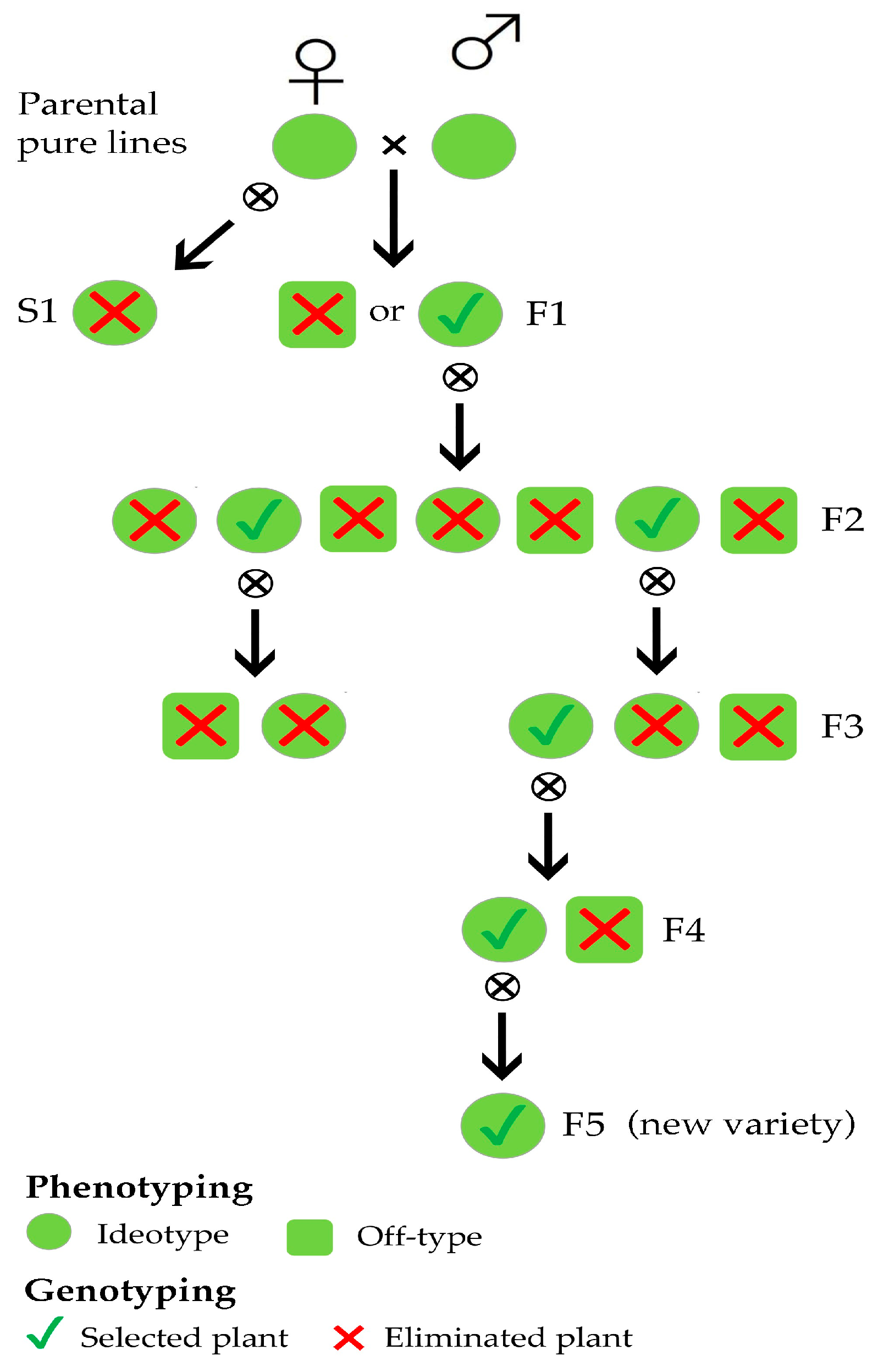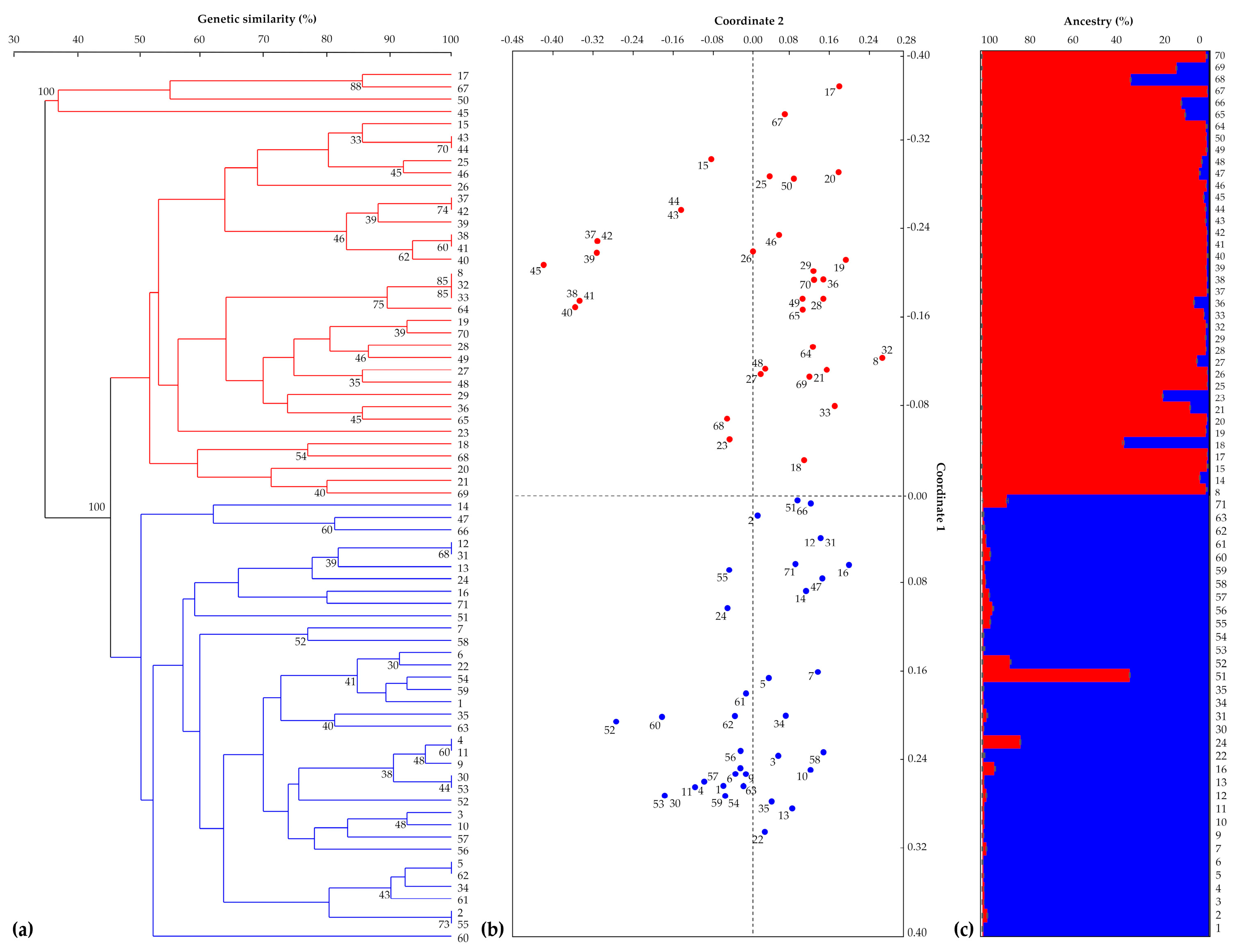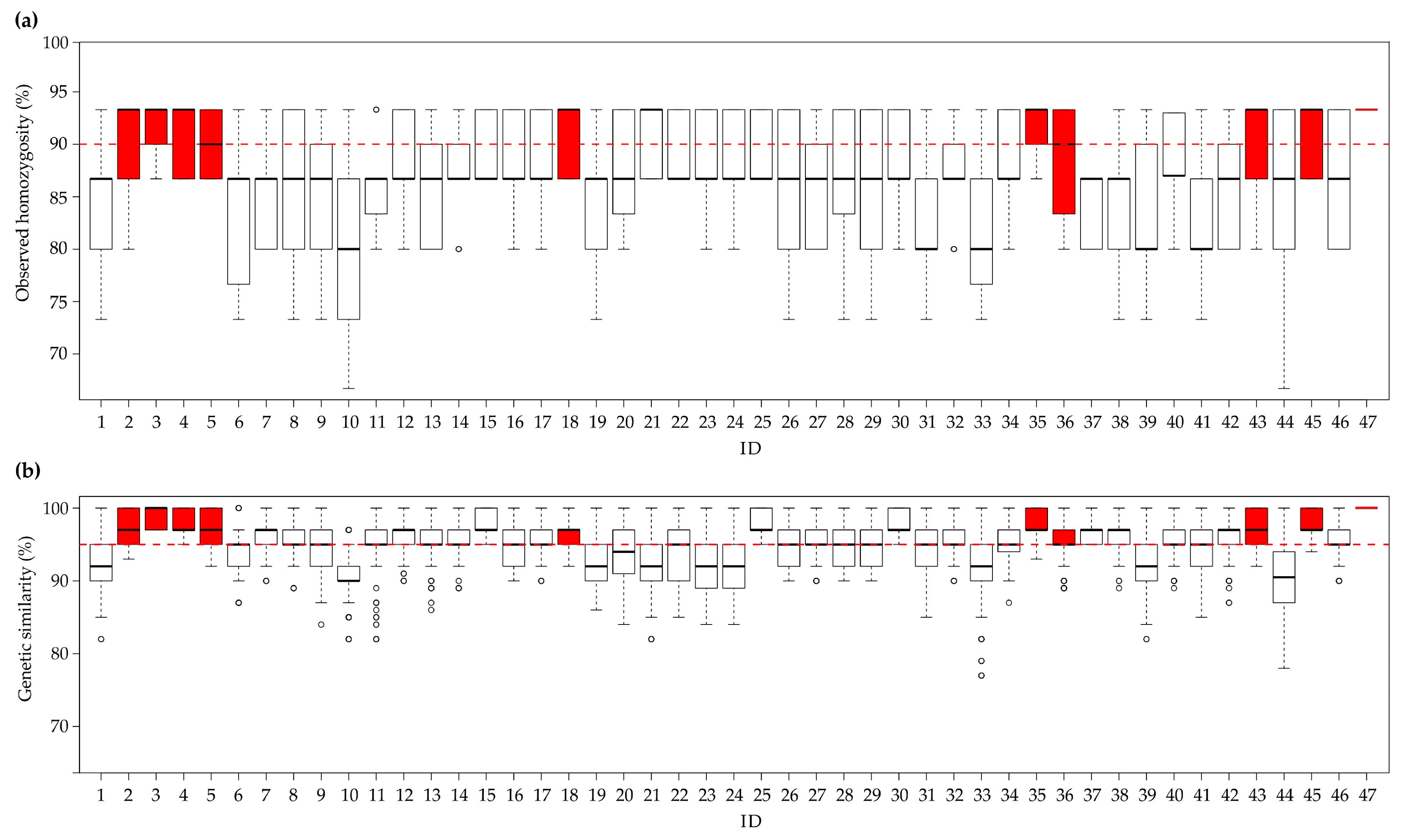The Molecular Determination of Hybridity and Homozygosity Estimates in Breeding Populations of Lettuce (Lactuca sativa L.)
Abstract
:1. Introduction
2. Materials and Methods
2.1. Plant Materials and Breeding Techniques
2.2. DNA Isolation
2.3. Primer Design and Testing of SSR Marker Amplification
2.4. Genotyping and Data Analysis
3. Results
3.1. Parental Lines
3.2. Determination of Hybridity
3.3. Lettuce Breeding Populations
4. Discussion
5. Conclusions
Supplementary Materials
Author Contributions
Funding
Acknowledgments
Conflicts of Interest
References
- Wang, S.; Wang, B.; Liu, J.; Ren, J.; Huang, X.; Zhou, G.; Wang, A. Novel polymorphic EST-based microsatellite markers characterized in lettuce (Lactuca sativa). Biologia 2017, 72, 1300–1305. [Google Scholar] [CrossRef]
- Nagata, R. Clip-and-wash Method of Emasculation for Lettuce. HortScience 1992, 27, 907–908. [Google Scholar] [CrossRef] [Green Version]
- Barcaccia, G.; Falcinelli, M. Genetica e Genomica; Liguori Editore, S.r.l.: Naples, Italy, 2006; Volume 3. [Google Scholar]
- Oliver, G.W. New methods of plant breeding. J. Hered. 1910, 1, 21–30. [Google Scholar] [CrossRef]
- Prohens-Tomás, J.; Nuez, F. Vegetables I: Asteraceae, Brassicaceae, Chenopodicaceae, and Cucurbitaceae; Springer Science & Business Media: Berlin, Germany, 2007; Volume 1. [Google Scholar]
- Patella, A.; Scariolo, F.; Palumbo, F.; Barcaccia, G. Genetic Structure of Cultivated Varieties of Radicchio (Cichorium intybus L.): A Comparison between F1 Hybrids and Synthetics. Plants 2019, 8, 213. [Google Scholar] [CrossRef] [PubMed]
- Palumbo, F.; Galla, G.; Vitulo, N.; Barcaccia, G. First draft genome sequencing of fennel (Foeniculum vulgare Mill.): Identification of simple sequence repeats and their application in marker-assisted breeding. Mol. Breed. 2018, 38, 122. [Google Scholar] [CrossRef]
- Jha, N.; Jacob, S.; Nepolean, T.; Jain, S.; Kumar, M. SSR markers based DNA fingerprinting and it’s utility in testing purity of eggplant hybrid seeds. Qual. Assur. Saf. Crop. Foods 2016, 8, 333–338. [Google Scholar] [CrossRef]
- Singh, D.; Singh, C.K.; Tomar, R.S.S.; Taunk, J.; Singh, R.; Maurya, S.; Chaturvedi, A.K.; Pal, M.; Singh, R.; Dubey, S.K. Molecular Assortment of Lens Species with Different Adaptations to Drought Conditions Using SSR Markers. PLoS ONE 2016, 11, e0147213. [Google Scholar] [CrossRef] [PubMed]
- Rauscher, G.; Simko, I. Development of genomic SSR markers for fingerprinting lettuce (Lactuca sativa L.) cultivars and mapping genes. BMC Plant Biol. 2013, 13, 11. [Google Scholar] [CrossRef]
- Truco, M.J.; Antonise, R.; Lavelle, D.; Ochoa, O.; Kozik, A.; Witsenboer, H.; Fort, S.B.; Jeuken, M.J.W.; Kesseli, R.V.; Lindhout, P.; et al. A high-density, integrated genetic linkage map of lettuce (Lactuca spp.). Theor. Appl. Genet. 2007, 115, 735–746. [Google Scholar] [CrossRef]
- Reyes-Chin-Wo, S.; Wang, Z.; Yang, X.; Kozik, A.; Arikit, S.; Song, C.; Xia, L.; Froenicke, L.; Lavelle, D.O.; Truco, M.-J.; et al. Genome assembly with in vitro proximity ligation data and whole-genome triplication in lettuce. Nat. Commun. 2017, 8, 14953. [Google Scholar] [CrossRef]
- Bull, C.T.; Goldman, P.H.; Hayes, R.; Madden, L.V.; Koike, S.T.; Ryder, E. Genetic Diversity of Lettuce for Resistance to Bacterial Leaf Spot Caused by Xanthomonas campestris pv. vitians. Plant Health Prog. 2007, 8, 11. [Google Scholar] [CrossRef]
- Giesbers, A.K.J.; Pelgrom, A.J.E.; Visser, R.G.F.; Niks, R.E.; Ackerveken, G.V.D.; Jeuken, M.J.W. Effector-mediated discovery of a novel resistance gene against Bremia lactucae in a nonhost lettuce species. New Phytol. 2017, 216, 915–926. [Google Scholar] [CrossRef] [PubMed]
- Macias-González, M.; Truco, M.J.; Bertier, L.D.; Jenni, S.; Simko, I.; Hayes, R.J.; Michelmore, R.W. Genetic architecture of tipburn resistance in lettuce. Theor. Appl. Genet. 2019, 132, 2209–2222. [Google Scholar] [CrossRef] [PubMed]
- Mamo, B.E.; Hayes, R.J.; Truco, M.J.; Puri, K.D.; Michelmore, R.W.; Subbarao, K.V.; Simko, I. The genetics of resistance to lettuce drop (Sclerotinia spp.) in lettuce in a recombinant inbred line population from Reine des Glaces × Eruption. Theor. Appl. Genet. 2019, 132, 2439–2460. [Google Scholar] [CrossRef] [PubMed]
- Hartman, Y.; Hooftman, D.A.P.; Uwimana, B.; Schranz, M.E.; Van De Wiel, C.C.M.; Smulders, M.J.M.; Visser, R.G.F.; Michelmore, R.W.; Van Tienderen, P.H. Abiotic stress QTL in lettuce crop–wild hybrids: Comparing greenhouse and field experiments. Ecol. Evol. 2014, 4, 2395–2409. [Google Scholar] [CrossRef] [PubMed]
- Su, W.; Tao, R.; Liu, W.; Yu, C.; Yue, Z.; He, S.; Lavelle, D.; Zhang, W.; Zhang, L.; An, G.; et al. Characterization of four polymorphic genes controlling red leaf colour in lettuce that have undergone disruptive selection since domestication. Plant Biotechnol. J. 2019. [Google Scholar] [CrossRef]
- El-Esawi, M.A. Molecular Genetic Markers for Assessing the Genetic Variation and Relationships in Lactuca Germplasm. Annu. Res. Rev. Biol. 2015, 8, 1–13. [Google Scholar] [CrossRef]
- Hayes, R.; Simko, I. Breeding lettuce for improved fresh-cut processing. Acta Hortic. 2016, 1141, 65–76. [Google Scholar] [CrossRef]
- Simko, I. Development of EST-SSR markers for the study of population structure in lettuce (Lactuca sativa L.). J. Hered. 2009, 100, 256–262. [Google Scholar] [CrossRef]
- Schuelke, M. An economic method for the fluorescent labeling of PCR fragments. Nat. Biotechnol. 2000, 18, 233–234. [Google Scholar] [CrossRef]
- Nonis, A.; Scortegagna, M.; Nonis, A.; Ruperti, B. PRaTo: A web-tool to select optimal primer pairs for qPCR. Biochem. Biophys. Res. Commun. 2011, 415, 707–708. [Google Scholar] [CrossRef] [PubMed]
- Saitou, N.; Nei, M. The neighbor-joining method: A new method for reconstructing phylogenetic trees. Mol. Biol. Evol. 1987, 4, 406–425. [Google Scholar] [PubMed]
- Hammer, Ø.; Harper, D.A.; Ryan, P.D. PAST: Paleontological statistics software package for education and data analysis. Palaeontol. Electron. 2001, 4, 1–9. [Google Scholar]
- Evanno, G.; Regnaut, S.; Goudet, J. Detecting the number of clusters of individuals using the software structure: A simulation study. Mol. Ecol. 2005, 14, 2611–2620. [Google Scholar] [CrossRef]
- Yeh, F.C.; Yang, R.-C.; Boyle, T. POPGENE Version 1.31; University of Alberta: Edmonton, AB, Canada, 1999. [Google Scholar]
- Palumbo, F.; Galla, G.; Martinez-Bello, L.; Barcaccia, G. Venetian Local Corn (Zea mays L.) Germplasm: Disclosing the Genetic Anatomy of Old Landraces Suited for Typical Cornmeal Mush Production. Diversity 2017, 9, 32. [Google Scholar] [CrossRef]
- Feng, J.Y.; Li, M.; Zhao, S.; Zhang, C.; Yang, S.T.; Qiao, S.; Tan, W.F.; Qu, H.J.; Wang, D.Y.; Pu, Z.G. Analysis of evolution and genetic diversity of sweetpotato and its related different polyploidy wild species I-trifida using RAD-seq. BMC Plant Biol. 2018, 18, 181. [Google Scholar] [CrossRef]
- Lawson, C. Plant Breeder’s Rights and Essentially Derived Varieties: Still Searching for Workable Solutions; European Intellectual Property Review 499: Griffith University Law School Research: Nathan, QLD, Australia, 2016; pp. 16–17. [Google Scholar]
- Hand, P.; Kift, N.; McClement, S.; Lynn, J.; Grube, R.; Schut, J.; Van der Arend, A.; Pink, D. Progress towards mapping QTLs for pest and disease resistance in lettuce. In Proceedings of the Eucarpia Leafy Vegetables Conference, Centre for Genetic Resources, Wageningen, The Netherlands, 22–24 May 2003; pp. 31–35. [Google Scholar]
- Šimko, I.; Pechenick, D.; McHale, L.; Truco, M.; Ochoa, O.; Michelmore, R.; Scheffler, B. Development of Molecular Markers for Marker-Assisted Selection of Dieback Disease Resistance in Lettuce (Lactuca sativa). Acta Hortic. 2010, 859, 401–408. [Google Scholar] [CrossRef]
- Sochor, M.; Jemelková, M.; Doležalová, I. Phenotyping and SSR markers as a tool for identification of duplicates in lettuce germplasm. Czech J. Genet. Plant Breed. 2019, 55, 110–119. [Google Scholar] [CrossRef] [Green Version]
- Bhat, J.A.; Shivaraj, S.M.; Ali, S.; Mir, Z.A.; Islam, A.; Deshmukh, R. Genomic Resources and Omics-Assisted Breeding Approaches for Pulse Crop Improvement. In Pulse Improvement; Springer: Berlin/Heidelberg, Germany, 2018; pp. 13–55. [Google Scholar]
- Phing Lau, W.C.; Latif, M.A.; Rafii, M.Y.; Ismail, M.R.; Puteh, A. Advances to improve the eating and cooking qualities of rice by marker-assisted breeding. Crit. Rev. Biotechnol. 2016, 36, 87–98. [Google Scholar] [CrossRef]
- FAO Site. Available online: http://www.fao.org/faostat/en/#data/QC (accessed on 11 September 2019).
- Uwimana, B.; Smulders, M.J.M.; Hooftman, D.A.P.; Hartman, Y.; Van Tienderen, P.H.; Jansen, J.; McHale, L.K.; Michelmore, R.W.; Van De Wiel, C.C.M.; Visser, R.G.F. Hybridization between crops and wild relatives: The contribution of cultivated lettuce to the vigour of crop-wild hybrids under drought, salinity and nutrient deficiency conditions. Theor. Appl. Genet. 2012, 125, 1097–1111. [Google Scholar] [CrossRef]




| Marker Name | ID | LG | Motif | Primer Sequence | Dye | Multiplex | |
|---|---|---|---|---|---|---|---|
| LSSA27-2 [10] | Lsat1 | 1 | (AC)7 | For | [M13]CACACTACCACCCAACACG | 6-FAM | 1 |
| Rev | ACCCTCTTCGCTTCTTCTT | ||||||
| SML-045 [21] | Lsat2 | 2 | (AAG)9/12 | For | ACAAAACCGTTTCACCCAAA | 6-FAM | 1 |
| Rev | [M13]AGCCCTGTCCTCTTCAGGAT | ||||||
| LSSB54 [10] | Lsat3 | 8 | (GT)10 | For | [PAN1]CTTGAGAGTGCTTGGAGAGGAT | VIC | 1 |
| Rev | CACATACAACAAGACAAGTCCCA | ||||||
| LSSA05 [10] | Lsat4 | 8 | (TC)18 | For | AGAACAACGGTAGCTTGTTAAATTG | VIC | 1 |
| Rev | [PAN1]ATCGTCGGTTAATCTTCGTCG | ||||||
| LSSA04 [10] | Lsat5 | 4 | (TC)14 | For | [PAN2]AAGGAAAGGAAGGGTTGACTTGT | NED | 1 |
| Rev | TTGGTGAAGAAAAGAGAGAGTTT | ||||||
| LSSA11 [10] | Lsat6 | 3 | (CT)20 | For | [PAN2]ACTCCCACTATCCTCTTTGCAT | NED | 1 |
| Rev | GCCCACATTCTTAATCTTGTCC | ||||||
| LSSA14 [10] | Lsat7 | 9 | (AG)18 | For | [PAN3]TGATGACTCCAGTCTTAGATACCA | PET | 1 |
| Rev | AGTCCCCGACTATCAGTCTCA | ||||||
| LSSB09 [10] | Lsat8 | 2 | (TG)8 | For | AGAATGAGAAGGATGAAATGGCTG | 6-FAM | 2 |
| Rev | [M13]AAACACCTTTAGCATCAAAATACCC | ||||||
| SML-029 [21] | Lsat9 | 9 | (GAG) 7/8 | For | [M13]AGCCCAGAAGAGCGTGATTA | 6-FAM | 2 |
| Rev | TGCAGGGCTCCTTGATCTAC | ||||||
| LSSB17-1 [10] | Lsat10 | 7 | (GT)11 | For | ACTAGGGCTCTAATACAACTTGT | VIC | 2 |
| Rev | [PAN1]TTGGCTTACAGTTATGGATTAAATG | ||||||
| LSSA17 [21] | Lsat11 | 3 | (AG)21 | For | [PAN1]AATGTGCGTGAGAGTTTCCTTT | VIC | 2 |
| Rev | CAAGAAGGCAGTGATGAAGTTG | ||||||
| LSSA12 [10] | Lsat12 | 5 | (GT)11 | For | [PAN2]ACAAGGCCCAATCCTTTTCT | NED | 2 |
| Rev | TCGAAAATTTGGAGAGAGTTTCTT | ||||||
| LSSA15 [10] | Lsat13 | 1 | (AC)11 | For | GCCCAACCCAAGAAGAGGAG | PET | 2 |
| Rev | [PAN3]TGGAGAGGAGTGGAGAGTGTT | ||||||
| LSSA28-1 [10] | Lsat14 | 4 | (GA)28 | For | TTCATCTCTCTCCTCCTTCAGC | 6-FAM | 3 |
| Rev | [M13]ATCCCCATTGTCCTCCC | ||||||
| LSSA21-1 [10] | Lsat15 | 8 | (TC)19 | For | [PAN2]TTGTACCCAGTTGTCCAAACAG | NED | 3 |
| Rev | CAGATTGTTGCAGATTTCTTCG | ||||||
| LSSB68 [10] | Lsat16 | na | (CT)20 | For | GTCTGTGTGGTTTTGGT | PET | 3 |
| Rev | [PAN3]TGTGGTGGAGTGTGATTT | ||||||
© 2019 by the authors. Licensee MDPI, Basel, Switzerland. This article is an open access article distributed under the terms and conditions of the Creative Commons Attribution (CC BY) license (http://creativecommons.org/licenses/by/4.0/).
Share and Cite
Patella, A.; Palumbo, F.; Galla, G.; Barcaccia, G. The Molecular Determination of Hybridity and Homozygosity Estimates in Breeding Populations of Lettuce (Lactuca sativa L.). Genes 2019, 10, 916. https://doi.org/10.3390/genes10110916
Patella A, Palumbo F, Galla G, Barcaccia G. The Molecular Determination of Hybridity and Homozygosity Estimates in Breeding Populations of Lettuce (Lactuca sativa L.). Genes. 2019; 10(11):916. https://doi.org/10.3390/genes10110916
Chicago/Turabian StylePatella, Alice, Fabio Palumbo, Giulio Galla, and Gianni Barcaccia. 2019. "The Molecular Determination of Hybridity and Homozygosity Estimates in Breeding Populations of Lettuce (Lactuca sativa L.)" Genes 10, no. 11: 916. https://doi.org/10.3390/genes10110916






